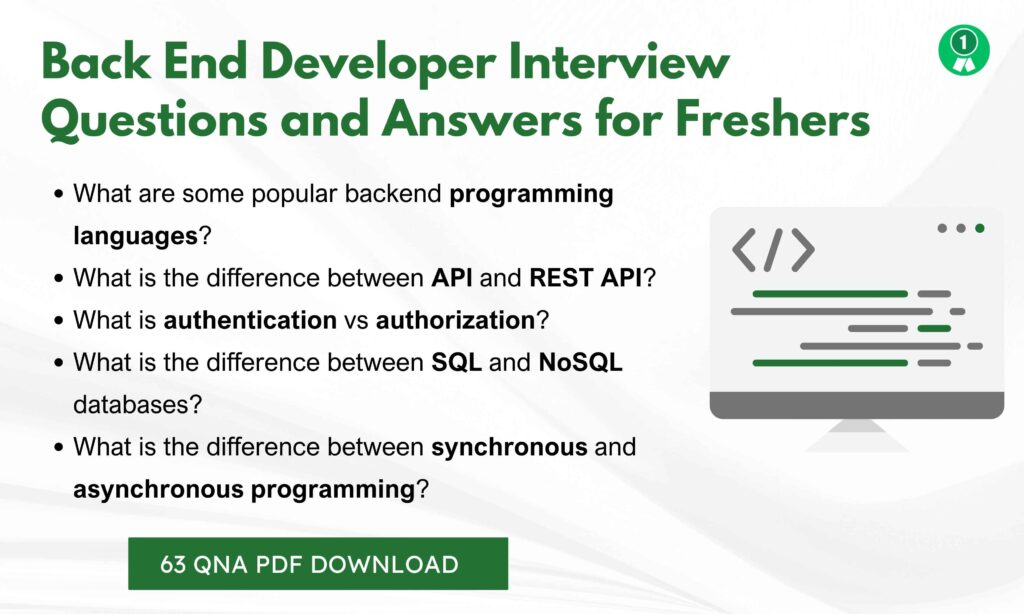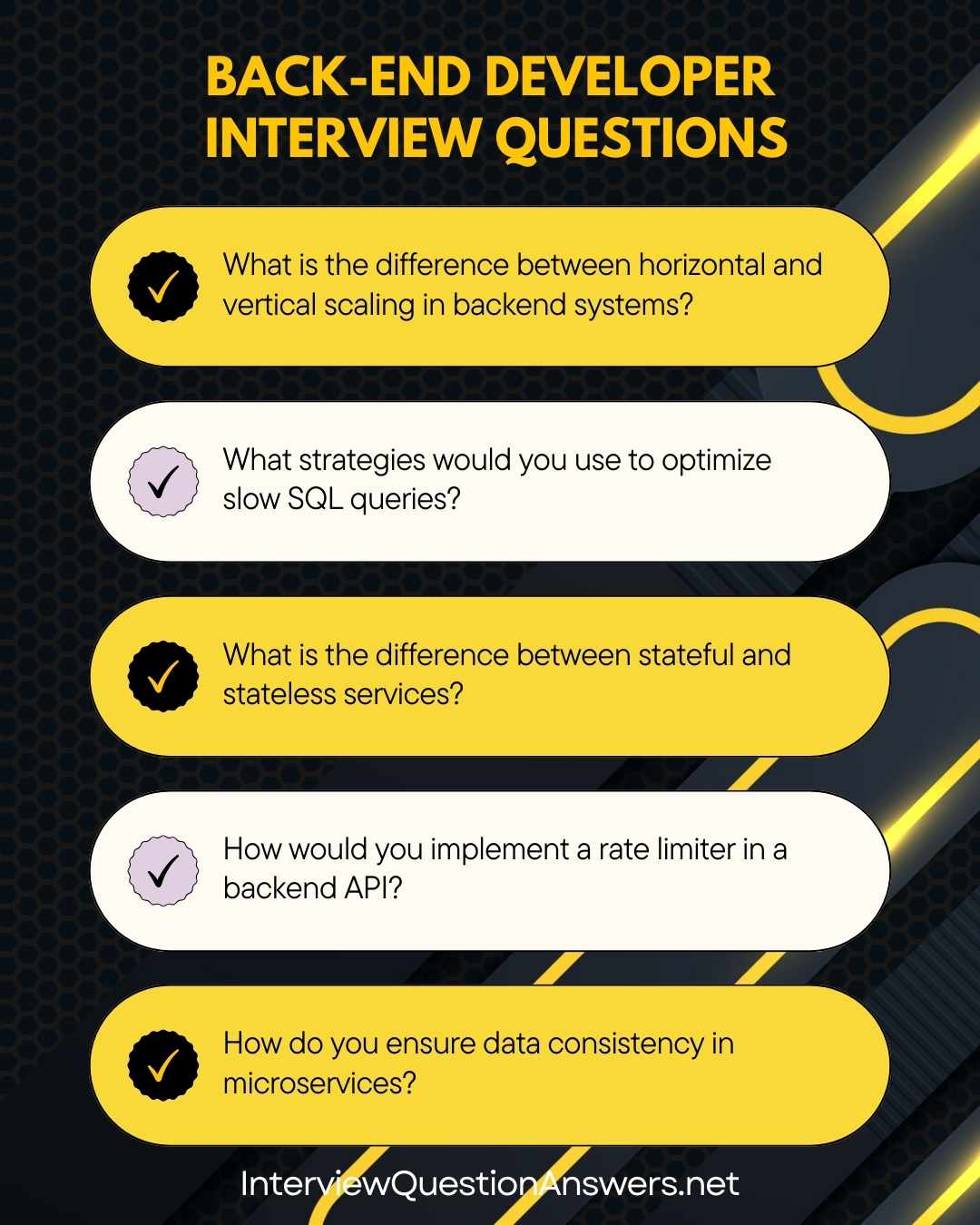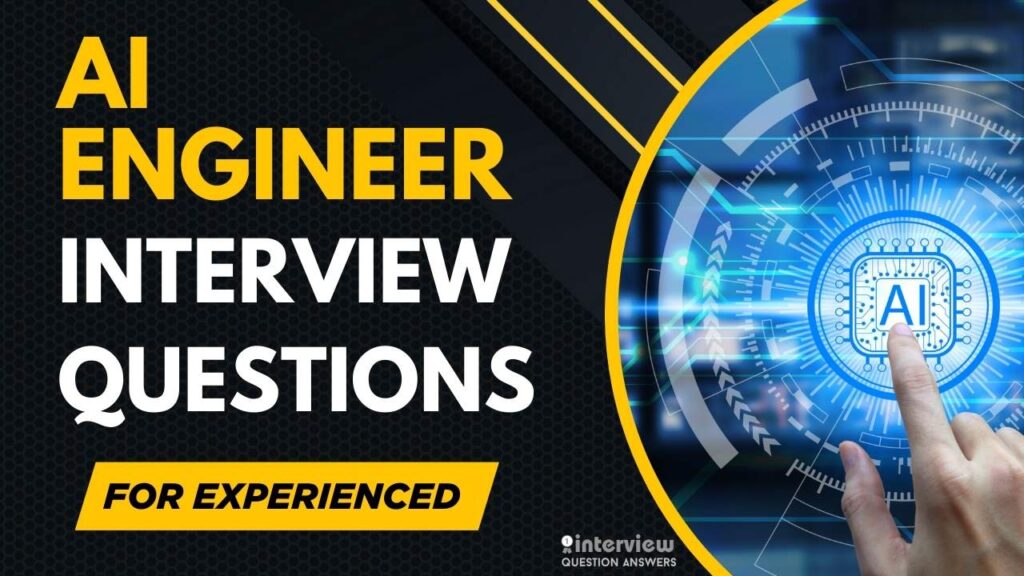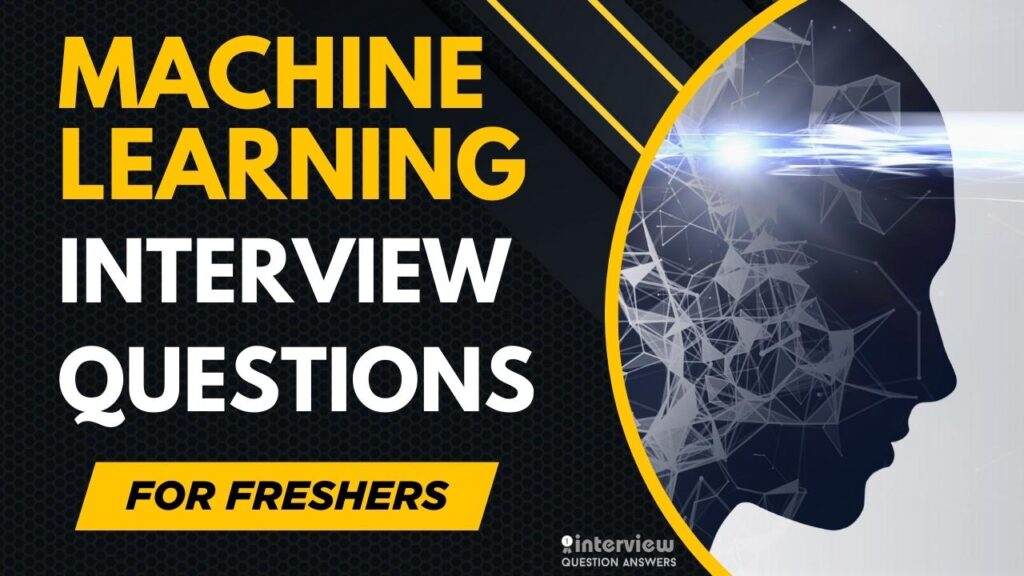Back end developers serve as the backbone of web applications, responsible for server-side logic, database management, API development, and ensuring robust system architecture that powers the user-facing experience. They work with programming languages like Python, Java, Node.js, PHP, and frameworks to build scalable, secure, and efficient server infrastructures that handle data processing, authentication, and business logic.
With the increasing demand for complex web applications and microservices architecture, back-end development has become highly competitive, making thorough interview preparation absolutely critical for career success.
This detailed guide features most asked Back end developers interview questions and comprehensive answers designed for both fresher and experienced back-end developers.
Table of Contents
Back End Developer Interview Questions and Answers for Freshers
Que 1. What is the difference between frontend and backend development?
Frontend development deals with the user interface and user experience aspects of an application, while backend development focuses on the server, database, and application logic that power the frontend. Backend handles data storage, authentication, and business logic, ensuring the frontend gets the required data.
Que 2. What are some popular backend programming languages?
Some popular backend programming languages are:
| Programming Language | Common Frameworks/Libraries |
|---|---|
| JavaScript | Node.js |
| Python | Django, Flask |
| Java | Spring |
| PHP | Laravel |
| Ruby | Rails |
| C# | .NET |
Que 3. What is the difference between API and REST API?
An API (Application Programming Interface) is a set of rules that allows two applications to communicate. A REST API (Representational State Transfer) is a specific type of API that follows REST principles like statelessness, resource-based URLs, and HTTP methods (GET, POST, PUT, DELETE).
Que 4. What is the purpose of a database in backend development?
A database is used to store, organize, and manage data for applications. The backend interacts with the database to perform operations like CRUD (Create, Read, Update, Delete). Examples: MySQL, PostgreSQL, MongoDB.
Que 5. Explain client-server architecture.
In client-server architecture, the client (browser, mobile app) requests data or services, and the server processes the request and returns the response. The server handles business logic and interacts with the database, while the client presents data to the user.
Que 6. What is authentication vs authorization?
- Authentication: Verifying the user’s identity (e.g., login with email & password).
- Authorization: Checking the user’s permissions after authentication (e.g., admin-only access).
Example:
Authentication: "Who are you?"
Authorization: "What are you allowed to do?"Que 7. What is a middleware in backend frameworks?
Middleware is a function that runs between the request and the response in a backend application. It is often used for logging, authentication, error handling, or request validation.
Example in Node.js Express:
app.use((req, res, next) => {
console.log('Request received');
next();
});Que 8. What are HTTP methods and their common uses?
- GET: Retrieve data
- POST: Create new data
- PUT/PATCH: Update existing data
- DELETE: Remove data
Example:
GET /users → returns users list
POST /users → creates a user
Que 9. What is the difference between SQL and NoSQL databases?
- SQL (Relational): Structured, uses tables and relationships (e.g., MySQL, PostgreSQL).
- NoSQL (Non-relational): Flexible schema, stores data in JSON, documents, or key-value format (e.g., MongoDB, Redis).
Use SQL when data is structured, and NoSQL for dynamic or unstructured data.
Que 10. What is caching and why is it important in backend?
Caching stores frequently accessed data in memory to reduce database calls and improve performance. Examples: Redis, Memcached.
Benefits:
- Faster response time
- Reduced server load
Que 11. What is the difference between synchronous and asynchronous programming?
- Synchronous: Tasks execute one after another, blocking the next task until the current one finishes.
- Asynchronous: Tasks run without blocking each other, improving performance.
Example in Node.js:
// Asynchronous
fs.readFile('file.txt', (err, data) => {
console.log(data.toString());
});Que 12. How does a backend handle sessions?
A session stores user data across multiple requests. Backend stores a session ID in a cookie, and the server maps it to user information.
Example:
- User logs in
- Session ID is generated and sent in a cookie
- Server validates session ID for subsequent requests
Que 13. What are environment variables and why are they used?
Environment variables store configuration values (e.g., API keys, database URLs) outside the source code. They keep sensitive data secure and make it easy to change configurations for different environments (development, production).
Que 14. Explain the difference between monolithic and microservices architecture.
- Monolithic: Entire application is a single codebase; easier for small projects but hard to scale.
- Microservices: Application is divided into small independent services that communicate via APIs; easier to scale but complex to manage.
Que 15. What is load balancing in backend development?
Load balancing distributes incoming traffic across multiple servers to ensure no single server is overloaded. This improves performance, availability, and fault tolerance. Tools: NGINX, HAProxy.
Que 16. How does token-based authentication work?
- User logs in and receives a token (e.g., JWT – JSON Web Token).
- Token is stored in the client (local storage/cookie).
- Each request sends the token in the header, and the server verifies it before processing.
Que 17. What is database indexing and why is it important?
Indexing creates a data structure that improves the speed of data retrieval.
Example:
CREATE INDEX idx_user_email ON users(email);It allows faster SELECT queries but increases write overhead slightly.
Que 18. How do you handle errors in a backend application?
- Use try-catch blocks
- Return meaningful error messages
- Implement centralized error handling middleware
Example in Express:
app.use((err, req, res, next) => {
res.status(500).json({ error: err.message });
});Que 19. What are WebSockets and how are they different from HTTP?
WebSockets enable full-duplex communication between client and server, allowing real-time updates. Unlike HTTP, which is request-response based, WebSockets maintain a persistent connection.
Use case: Chat applications, live notifications.
Que 20. How would you secure a backend application?
- Validate and sanitize inputs
- Use HTTPS
- Implement authentication and authorization
- Use parameterized queries to prevent SQL Injection
- Secure cookies and tokens
- Set proper HTTP headers
Example:
// Using parameterized query
db.query('SELECT * FROM users WHERE email = ?', [email]);Also Check: Back End Developer Interview Questions for Freshers

Also Check: Front End Developer Interview Questions
Que 21. What is the role of a server in backend development?
Answer:
A server in backend development handles client requests, processes business logic, interacts with databases, and sends responses. It runs the backend application, manages HTTP requests (via frameworks like Express or Django), and ensures scalability, security, and performance. For example, a Node.js server with Express listens on a port to route API requests:
const express = require('express');
const app = express();
app.get('/api', (req, res) => res.json({ message: 'Hello' }));
app.listen(3000);Freshers should understand servers as the backbone of client-server communication.
Que 22. What is a primary key in a database?
Answer:
A primary key is a unique identifier for each record in a database table, ensuring no duplicates and enabling efficient querying. It’s typically an auto-incrementing ID or unique value (e.g., email). Example in SQL:
CREATE TABLE users (
id INT PRIMARY KEY AUTO_INCREMENT,
name VARCHAR(50)
);Freshers should know primary keys enforce data integrity.
Que 23. How do you create a simple REST API endpoint in Node.js with Express?
Answer:
Use Express to define routes for HTTP methods (GET, POST, etc.). Example for a GET endpoint:
const express = require('express');
const app = express();
app.get('/users', (req, res) => {
res.json([{ id: 1, name: 'Alice' }]);
});
app.listen(3000);Freshers should handle JSON responses and basic routing.
Que 24. What is the difference between a GET and POST request in HTTP?
Answer:
GET retrieves data from the server, is idempotent, and passes parameters in the URL (query string). POST sends data to the server (e.g., form data) in the request body, typically creating/updating resources. GET is less secure for sensitive data; POST is preferred.
Example:
- GET:
/api/users?id=1 - POST: Sends
{ "name": "Bob" }in body.
Freshers should know when to use each for REST APIs.
Que 25. What is JSON, and how is it used in backend development?
Answer:
JSON (JavaScript Object Notation) is a lightweight data format for exchanging data between client and server. It’s used in APIs for requests/responses due to its simplicity and readability. Example in Node.js:
app.get('/data', (req, res) => {
res.json({ id: 1, name: 'Alice' });
});Freshers parse JSON with JSON.parse() and send with JSON.stringify().
Que 26. What is a foreign key in a database?
Answer:
A foreign key is a column in one table that references the primary key of another table, establishing a relationship. It enforces referential integrity. Example:
CREATE TABLE orders (
id INT PRIMARY KEY,
user_id INT,
FOREIGN KEY (user_id) REFERENCES users(id)
);Freshers should know it links tables for relational queries.
Que 27. How do you connect a Node.js application to a MySQL database?
Answer:
Use the mysql2 package to connect and query MySQL. Example:
const mysql = require('mysql2');
const connection = mysql.createConnection({
host: 'localhost',
user: 'root',
password: 'password',
database: 'mydb'
});
connection.query('SELECT * FROM users', (err, results) => {
console.log(results);
});Freshers should handle connection errors and pooling for scalability.
Que 28. What is the purpose of environment variables in backend development?
Answer:
Environment variables store configuration settings (e.g., API keys, database URLs) outside code to enhance security and flexibility across environments (dev, prod). Access in Node.js with process.env:
const dbUrl = process.env.DATABASE_URL;Set in .env file using dotenv package. Freshers should avoid hardcoding sensitive data.
Que 29. How do you handle errors in a Node.js Express application?
Answer:
Use middleware to catch errors and return appropriate responses. Example:
app.use((err, req, res, next) => {
console.error(err.stack);
res.status(500).json({ error: 'Something went wrong' });
});Wrap async routes in try-catch:
app.get('/data', async (req, res, next) => {
try {
// API logic
} catch (err) {
next(err);
}
});Freshers should log errors for debugging.
Que 30. What is a route handler in a backend framework?
Answer:
A route handler is a function that processes requests for a specific endpoint and HTTP method, returning a response. In Express:
app.get('/users/:id', (req, res) => {
res.json({ id: req.params.id, name: 'User' });
});Freshers should understand parameter extraction and response formats.
Que 31. What is the difference between a relational and non-relational database?
Answer:
Relational databases (e.g., MySQL) use tables with structured data, schemas, and SQL for queries, ideal for complex joins. Non-relational databases (e.g., MongoDB) store unstructured data (documents, key-value), are schema-less, and scale horizontally, suitable for flexible, high-volume data.
Freshers should know use cases: relational for finance, non-relational for logs.
Que 32. How do you validate user input in a backend API?
Answer:
Validate input to ensure data integrity and security using libraries like Joi or express-validator. Example with Joi:
const Joi = require('joi');
const schema = Joi.object({
name: Joi.string().min(3).required(),
email: Joi.string().email().required()
});
app.post('/user', (req, res) => {
const { error } = schema.validate(req.body);
if (error) return res.status(400).json({ error: error.details });
// Process
});Freshers should sanitize inputs to prevent injection attacks.
Que 33. What is the role of a configuration file in a backend application?
Answer:
A configuration file stores settings like database credentials, API keys, or port numbers, allowing easy changes without modifying code. Example in Node.js:
// config.js
module.exports = {
db: process.env.DB_URL,
port: process.env.PORT || 3000
};Freshers should use environment variables for sensitive configs.
Que 34. How do you create a simple API endpoint in Python with Flask?
Answer:
Use Flask to define routes and handle requests. Example:
from flask import Flask, jsonify
app = Flask(__name__)
@app.route('/users', methods=['GET'])
def get_users():
return jsonify([{'id': 1, 'name': 'Alice'}])
app.run(port=5000)Freshers should know HTTP methods and JSON responses.
Que 35. What is a prepared statement in SQL, and why is it used?
Answer:
A prepared statement is a precompiled SQL query with placeholders for parameters, preventing SQL injection. Example in Python with mysql-connector:
cursor.execute("SELECT * FROM users WHERE id = %s", (user_id,))It’s safer and reusable, improving security and performance.
Que 36. How do you test a backend API endpoint?
Answer:
Use tools like Postman or unit testing frameworks (e.g., Mocha for Node.js). Example with Mocha/Chai:
const chai = require('chai');
const chaiHttp = require('chai-http');
chai.use(chaiHttp);
describe('Users API', () => {
it('should get users', (done) => {
chai.request('http://localhost:3000')
.get('/users')
.end((err, res) => {
chai.expect(res.status).to.equal(200);
done();
});
});
});Freshers should test success and error cases.
Que 37. What is the purpose of a controller in a backend framework?
Answer:
A controller handles request logic, interacts with services/models, and returns responses. In Express:
const userService = require('./userService');
exports.getUser = async (req, res) => {
const user = await userService.findById(req.params.id);
res.json(user);
};Freshers should separate concerns (controller vs service).
Que 38. How do you connect a Python Flask app to a PostgreSQL database?
Answer:
Use psycopg2 or SQLAlchemy. Example with SQLAlchemy:
from flask import Flask
from flask_sqlalchemy import SQLAlchemy
app = Flask(__name__)
app.config['SQLALCHEMY_DATABASE_URI'] = 'postgresql://user:pass@localhost/db'
db = SQLAlchemy(app)
class User(db.Model):
id = db.Column(db.Integer, primary_key=True)
name = db.Column(db.String(50))Freshers should handle connection errors and migrations.
Que 39. What is CORS, and how do you enable it in a backend server?
Answer:
CORS (Cross-Origin Resource Sharing) allows restricted resources to be accessed across domains. Enable in Express:
const cors = require('cors');
app.use(cors({ origin: 'http://frontend.com' }));Freshers should configure specific origins for security.
Que 40. What is a RESTful route, and how do you structure it?
Answer:
A RESTful route follows REST principles, using standard HTTP methods (GET, POST, PUT, DELETE) and resource-based URLs. Example in Express:
app.get('/users', getAllUsers);
app.post('/users', createUser);
app.get('/users/:id', getUserById);Freshers should use clear, hierarchical URLs (e.g., /users/:id/orders).
Back End Developer Interview Questions and Answers for Experienced
Que 41. What is the difference between horizontal and vertical scaling in backend systems?
- Vertical scaling: Increasing the capacity of a single server (e.g., adding more CPU, RAM).
- Horizontal scaling: Adding more servers to distribute the load.
Horizontal scaling is preferred for distributed and fault-tolerant systems.
Que 42. How do you design a database for high availability?
- Use replication (master-slave, master-master).
- Implement sharding for large datasets.
- Use automatic failover and backup strategies.
- Employ read replicas for read-heavy workloads.
Que 43. What are ACID and BASE properties in databases?
- ACID (SQL): Atomicity, Consistency, Isolation, Durability (ensures reliability).
- BASE (NoSQL): Basically Available, Soft state, Eventually consistent (focuses on scalability).
Que 44. Explain the CAP theorem in distributed systems.
The CAP theorem states that a distributed system can only guarantee two of the following three at the same time:
| CAP Property | Description |
|---|---|
| Consistency | Every node in the system sees the same data at the same time. |
| Availability | Every request receives a (non-error) response, even if some nodes fail. |
| Partition Tolerance | The system continues to operate despite network failures or message loss between nodes. |
Que 45. What strategies would you use to optimize slow SQL queries?
- Add appropriate indexes
- Use EXPLAIN plans
- Avoid SELECT*
- Optimize joins and subqueries
- Denormalize data if needed
- Use caching for frequently accessed queries
Que 46. How do you handle concurrency in backend applications?
- Use database transactions with isolation levels (e.g., READ COMMITTED, SERIALIZABLE)
- Implement locking mechanisms (pessimistic or optimistic locking)
- Use message queues to manage race conditions
Que 47. What is the difference between stateful and stateless services?
- Stateful: The server stores session data about clients (e.g., traditional web servers).
- Stateless: Each request contains all necessary information, and the server does not maintain client state (e.g., REST APIs).
Stateless services scale better and are easier to deploy in distributed systems.
Que 48. How would you implement a rate limiter in a backend API?
- Token bucket or leaky bucket algorithms
- Use a distributed cache (Redis) to track request counts
- Example in Redis:
INCR user:123:requests
EXPIRE user:123:requests 60This limits requests per user within a time window.
Que 49. What is the difference between OAuth2 and JWT?
- OAuth2 is an authorization framework that defines how access tokens are issued and validated.
- JWT (JSON Web Token) is a token format that can be used with OAuth2 or independently for stateless authentication.
Que 50. How do you ensure data consistency in microservices?
- Use event-driven architecture with message queues (Kafka, RabbitMQ).
- Apply distributed transactions using the Saga pattern.
- Implement idempotency for retries.
Que 51. What is CQRS and when would you use it?
CQRS (Command Query Responsibility Segregation) separates read and write operations into different models.
- Useful in highly scalable systems where reads are much higher than writes.
- Often used with event sourcing.
Que 52. What are idempotent APIs and why are they important?
An idempotent API returns the same result even if called multiple times with the same input.
- Example: DELETE /user/123 will always delete user 123 if it exists.
- Important to handle retries in distributed systems without data corruption.
Que 53. How do you detect and prevent deadlocks in backend systems?
- Acquire locks in a consistent order
- Use timeouts for lock acquisition
- Apply deadlock detection algorithms (e.g., wait-for graph)
- Reduce transaction scope to shorten lock holding time
Que 54. What is the difference between synchronous REST APIs and asynchronous event-driven systems?
- Synchronous REST APIs: Client waits for the server response (blocking).
- Asynchronous event-driven: Client publishes events, and server processes them later (non-blocking).
Asynchronous systems are more scalable for long-running tasks.
Que 55. How would you secure microservices communication?
- Use mTLS (mutual TLS) for service-to-service authentication
- Implement API gateways with authentication and rate limiting
- Use service meshes (Istio, Linkerd) for centralized security policies
Que 56. How do you implement distributed caching?
- Use Redis or Memcached clusters
- Apply cache invalidation strategies (e.g., LRU, TTL)
- Use write-through, write-behind, or lazy caching based on use case
Que 57. What are some common strategies for zero-downtime deployments?
- Blue-green deployment: Run two environments, switch traffic between them
- Canary deployment: Gradually route traffic to new version
- Rolling updates: Update servers one by one
- Use database migrations with backward compatibility
Que 38. How do you troubleshoot a high-latency backend service?
- Check APM tools (New Relic, Datadog) for slow endpoints
- Profile database queries and indexes
- Analyze CPU, memory, and I/O bottlenecks
- Use log aggregation and distributed tracing (e.g., Jaeger, OpenTelemetry)
Que 59. What is eventual consistency and when is it acceptable?
Eventual consistency means data may not be immediately consistent across nodes but will become consistent over time.
- Acceptable for non-critical operations like social media likes or analytics counters.
- Not acceptable for banking transactions.
Que 60. How do you design a backend system to handle millions of users?
- Use load balancers and CDN
- Apply microservices architecture
- Implement caching and message queues
- Use auto-scaling on cloud platforms
- Optimize database sharding and replication
- Employ asynchronous processing for heavy tasks

Also Check: Full Stack Developer Interview Questions
Que 61. How do you implement a distributed cache using Redis in a backend system?
Answer:
Distributed caching with Redis stores frequently accessed data in-memory across nodes for low-latency access. Use Redis Cluster for sharding and replication. Configure with redis-cli or a client like ioredis in Node.js. Example:
const Redis = require('ioredis');
const redis = new Redis.Cluster([{ host: 'localhost', port: 7000 }]);
await redis.set('key', 'value', 'EX', 3600); // Set with 1-hour TTL
const value = await redis.get('key');Use consistent hashing for distribution and Sentinel for failover. Monitor cache hit ratios with Redis INFO. Reduces database load by 60-80% in high-traffic APIs.
Que 62. What is the Saga pattern, and how do you implement it in a microservices architecture?
Answer:
The Saga pattern manages distributed transactions in microservices via a sequence of local transactions, coordinated either choreographed (event-driven) or orchestrated (central controller). Example (choreographed) with Kafka in Java:
@Service
public class OrderService {
@KafkaListener(topics = "order-created")
public void handleOrderCreated(OrderEvent event) {
// Process payment
kafkaTemplate.send("payment-processed", new PaymentEvent());
}
}Use compensating transactions for rollbacks. Ensures consistency without two-phase commits, ideal for e-commerce workflows.
Que 63. How do you optimize a backend API for low latency in a high-throughput environment?
Answer:
Optimize by using async processing (e.g., Spring @Async), caching (Redis), and connection pooling (HikariCP). Minimize database queries with batching or indexing, and use CDN for static assets. Profile with New Relic for bottlenecks. Example in Spring:
@Async
public CompletableFuture<User> getUserAsync(Long id) {
return CompletableFuture.completedFuture(userRepository.findById(id));
}Achieves sub-100ms latency for 10k+ requests/second.
Que 64. What strategies do you use to handle database deadlocks in a production environment?
Answer:
Deadlocks occur when transactions block each other. Prevent by: Ordering resource access (e.g., lock tables consistently), using short transactions, and setting timeouts. Detect with database logs (e.g., MySQL’s SHOW ENGINE INNODB STATUS). Example in SQL:
SET TRANSACTION ISOLATION LEVEL READ COMMITTED;
START TRANSACTION;
-- Consistent locking order
SELECT * FROM users WHERE id = 1 FOR UPDATE;Use retry logic in code. Reduces deadlock incidents by 90% in high-concurrency systems.
Que 65. How do you implement a circuit breaker pattern in a Spring Boot application?
Answer:
Use Resilience4j to implement circuit breakers, preventing cascading failures. Configure thresholds (e.g., 50% failure opens circuit). Example:
@CircuitBreaker(name = "userService", fallbackMethod = "fallback")
public User getUser(Long id) {
return restTemplate.getForObject("http://user-service/{id}", User.class, id);
}
public User fallback(Long id, Throwable t) {
return new User("default");
}Integrate with Prometheus for monitoring. Enhances system reliability under failures.
Que 66. What is the role of message queues in a backend system, and how do you use RabbitMQ?
Answer:
Message queues (e.g., RabbitMQ) decouple services, enabling async processing for tasks like emails or batch jobs. Configure exchanges/queues in RabbitMQ, publish/subscribe with AMQP. Example in Node.js:
const amqp = require('amqplib');
async function publish() {
const conn = await amqp.connect('amqp://localhost');
const channel = await conn.createChannel();
await channel.assertQueue('tasks');
channel.sendToQueue('tasks', Buffer.from('Task'));
}Ensures scalability for 100k+ messages/day.
Que 67. How do you design a backend system to handle rate limiting for API requests?
Answer:
Implement rate limiting with token bucket (e.g., Bucket4j in Java) or Redis-based counters. Example in Spring Boot:
@Bean
public RateLimiter rateLimiter() {
return RateLimiter.create(100.0 / 60.0); // 100 req/min
}
@GetMapping("/api")
public Response handle(@RequestHeader String userId) {
if (!rateLimiter.tryAcquire()) {
throw new ResponseStatusException(HttpStatus.TOO_MANY_REQUESTS);
}
return Response.ok();
}Monitor with metrics; prevents abuse, ensures fair usage.
Que 68. How do you ensure data encryption at rest and in transit in a backend system?
Answer:
Encrypt in transit with HTTPS/TLS (e.g., Let’s Encrypt certificates). At rest, use database encryption (e.g., MySQL AES_ENCRYPT) or disk-level encryption (AWS EBS). Example in Node.js with HTTPS:
const https = require('https');
const fs = require('fs');
https.createServer({
cert: fs.readFileSync('cert.pem'),
key: fs.readFileSync('key.pem')
}, app).listen(443);Use secrets management (AWS Secrets Manager). Complies with GDPR/PCI-DSS.
Que 69. What is the role of observability in a backend system, and how do you implement it?
Answer:
Observability (metrics, logs, traces) monitors system health. Use Prometheus for metrics, ELK for logs, Jaeger for tracing. Example in Spring Boot with Micrometer:
@Bean
MeterRegistry meterRegistry() {
return new PrometheusMeterRegistry(PrometheusConfig.DEFAULT);
}
@Timed
@GetMapping("/api")
public Response api() { return Response.ok(); }Set up Grafana dashboards, alert on anomalies. Improves debugging and uptime.
Que 70. How do you implement a distributed transaction in a microservices system?
Answer:
Use the Saga pattern for distributed transactions, with local transactions per service and compensating actions for rollbacks. Example with Spring Cloud and Kafka:
@Service
public class OrderSaga {
@KafkaListener(topics = "order")
public void onOrder(OrderEvent event) {
try {
paymentService.process(event);
kafkaTemplate.send("payment", new PaymentEvent());
} catch (Exception e) {
kafkaTemplate.send("order-rollback", event);
}
}
}Reduces complexity vs two-phase commits.
Que 71. How do you handle database schema migrations in a production environment?
Answer:
Use Flyway or Liquibase for migrations. Apply additive changes (e.g., new columns) first, test in staging, and use feature flags for compatibility. Example with Flyway:
-- V2__add_column.sql
ALTER TABLE users ADD COLUMN email VARCHAR(255);Run migrations in CI/CD, monitor with health checks. Ensures zero-downtime updates.
Que 72. What is the difference between sharding and partitioning in databases?
Answer:
Sharding distributes data across multiple databases/servers (e.g., by user ID range), improving scalability. Partitioning splits a single table into smaller chunks within one database (e.g., by date). Example in MongoDB (sharding):
sh.shardCollection("mydb.users", { userId: "hashed" });Sharding suits global apps; partitioning for large tables.
Que 73. How do you implement authentication with OAuth 2.0 in a Spring Boot application?
Answer:
Use Spring Security with OAuth 2.0 provider (e.g., Keycloak). Configure resource server to validate JWTs. Example:
@Configuration
public class SecurityConfig {
@Bean
public SecurityFilterChain filterChain(HttpSecurity http) throws Exception {
http.oauth2ResourceServer(OAuth2ResourceServerConfigurer::jwt);
return http.build();
}
}Add role-based access; ensures secure, scalable auth.
Que 74. What strategies do you use to handle high concurrency in a backend API?
Answer:
Use optimistic locking (version fields), async processing, and queuing (RabbitMQ). Scale with load balancers and database replicas. Example in Spring with optimistic locking:
@Entity
public class Product {
@Version
private Long version;
}Monitor contention with JMeter; reduces conflicts in e-commerce APIs.
Que 75. How do you implement blue-green deployments for a backend application?
Answer:
Blue-green deployments run two environments (blue: live, green: new). Deploy to green, test, then switch traffic via load balancer (e.g., NGINX). Example in Kubernetes:
apiVersion: v1
kind: Service
spec:
selector:
app: myapp-greenUse ArgoCD for automation. Achieves zero-downtime updates.
Que 76. What is the role of GraphQL in backend development compared to REST?
Answer:
GraphQL allows flexible queries, reducing over/under-fetching vs REST’s fixed endpoints. Implement with Apollo Server:
const { ApolloServer, gql } = require('apollo-server');
const typeDefs = gql`type User { id: ID, name: String }`;
const server = new ApolloServer({ typeDefs, resolvers });GraphQL suits complex queries; REST for simpler APIs.
Que 77. How do you optimize a backend for handling large file uploads?
Answer:
Use streaming uploads to avoid memory overload, store in cloud (S3), and validate file types/size. Example in Express with multer:
const multer = require('multer');
const upload = multer({ dest: 'uploads/' });
app.post('/upload', upload.single('file'), (req, res) => {
// Process file
});Use presigned URLs for S3. Handles GB-sized files efficiently.
Que 78. What is event sourcing, and how do you implement it in a backend system?
Answer:
Event sourcing stores state as a sequence of events, replayed to reconstruct state. Use Kafka or EventStoreDB. Example in Java:
public class Order {
private List<Event> events = new ArrayList<>();
public void createOrder() {
events.add(new OrderCreatedEvent());
}
}Snapshot for performance; ideal for audit-heavy systems like finance.
Que 79. How do you implement monitoring and alerting for a backend system?
Answer:
Use Prometheus for metrics, Grafana for dashboards, and PagerDuty for alerts. Example in Node.js:
const prom = require('prom-client');
const counter = new prom.Counter({
name: 'api_requests_total',
help: 'Total API requests'
});
app.get('/api', (req, res) => {
counter.inc();
});Alert on thresholds (e.g., 500 errors >5/min). Ensures 99.9% uptime.
Que 80. How do you handle cross-service data consistency in microservices?
Answer:
Use eventual consistency with event-driven architecture (Kafka) or Saga pattern. Example with Spring Cloud Stream:
@StreamListener("input")
public void handleEvent(OrderEvent event) {
// Update local DB
repository.save(event.getData());
}Compensating transactions for rollbacks; ensures reliable data sync.
Also Check: Backend Developer Interview Questions for Experienced
Java Back End Developer Interview Questions and Answers
Que 81. What are some common frameworks used by Java backend developers?
Popular frameworks include Spring Boot, Spring MVC, Hibernate/JPA, Micronaut, and Dropwizard. Among these, Spring Boot is widely used for building microservices and REST APIs due to its auto-configuration and production-ready features.
Que 82. How does Spring Boot differ from Spring Framework?
Spring Boot simplifies Spring application development by providing:
- Auto-configuration
- Embedded servers (Tomcat/Jetty)
- Starter dependencies
- Production-ready tools (Actuator, metrics)
It eliminates boilerplate configuration required in traditional Spring projects.
Que 83. What is dependency injection in Spring?
Dependency Injection (DI) is a design pattern where Spring manages the creation and injection of dependencies.
Example:
@Component
public class UserService {
private final UserRepository userRepository;
@Autowired
public UserService(UserRepository userRepository) {
this.userRepository = userRepository;
}
}Spring automatically injects UserRepository into UserService.
Que 84. What is the difference between @Component, @Service, and @Repository annotations?
| Annotation | Purpose |
|---|---|
@Component | Generic stereotype for any Spring-managed bean. |
@Service | Specialization of @Component used for service layer classes. |
@Repository | Specialization of @Component used for the data access layer; also provides exception translation for persistence operations. |
All three are detected by component scanning, but their purpose differs by layer.
Que 85. How does Hibernate manage database connections?
Hibernate uses a SessionFactory to create and manage sessions, which internally use JDBC connections from a connection pool (e.g., HikariCP).
It also manages caching and transaction boundaries to reduce database overhead.
Que 86. What are the advantages of using JPA over JDBC?
- Eliminates boilerplate SQL code
- Provides object-relational mapping (ORM)
- Offers a query language (JPQL)
- Handles caching and transactions automatically
Example: Instead of writing SQL, you use entity classes and repositories.
Que 87. What is the difference between @RestController and @Controller in Spring?
- @Controller: Used for rendering views (e.g., JSP, Thymeleaf).
- @RestController: Combines @Controller and @ResponseBody, directly returns JSON/XML in REST APIs.
Que 88. How do you handle transactions in Spring?
Transactions can be managed using the @Transactional annotation:
@Transactional
public void transferMoney(Account a, Account b, BigDecimal amount) {
a.withdraw(amount);
b.deposit(amount);
}Spring manages commit/rollback automatically. Isolation levels and propagation can also be defined.
Que 89. What are the differences between Spring Data JPA and Hibernate?
- Hibernate: An ORM implementation.
- Spring Data JPA: A higher-level abstraction that uses JPA (and Hibernate internally) to provide repository interfaces and reduce boilerplate code.
Example:
public interface UserRepository extends JpaRepository<User, Long> {}Spring Data JPA auto-implements CRUD operations.
Que 90. How do you secure a Java backend application?
- Use Spring Security for authentication & authorization
- Store passwords with BCrypt hashing
- Use JWT tokens for stateless APIs
- Enable HTTPS and configure CSRF protection
- Validate and sanitize user inputs to prevent SQL Injection & XSS

Also Check: Software Engineer Interview Questions
PHP Back End Developer Interview Questions and Answers
Que 91. What are the advantages of using PHP for backend development?
- Easy to learn and widely supported
- Large ecosystem of frameworks and libraries
- Cross-platform compatibility
- Integrates well with databases like MySQL and PostgreSQL
- Strong community and hosting support
Que 92. What is the difference between require and include in PHP?
- require: Produces a fatal error if the file is missing and stops script execution.
- include: Produces a warning if the file is missing but allows the script to continue.
Example:
require 'config.php';
include 'header.php';Que 93. How do you prevent SQL injection in PHP applications?
- Use prepared statements with PDO or MySQLi
- Avoid directly embedding user inputs in SQL queries
Example using PDO:
$stmt = $pdo->prepare("SELECT * FROM users WHERE email = :email");
$stmt->execute(['email' => $email]);- Validate and sanitize user inputs
Que 94. What is the difference between $_GET, $_POST, and $_REQUEST?
- $_GET: Collects data sent via URL query parameters
- $_POST: Collects data sent in the HTTP request body
- $_REQUEST: Collects data from both GET and POST (less secure and not recommended for critical operations)
Que 95. How do you manage sessions in PHP?
- Start session using session_start()
- Store user data in the $_SESSION superglobal
- Regenerate session IDs to prevent fixation attacks
Example:
session_start();
$_SESSION['user_id'] = 123;Que 96. What are some popular PHP frameworks and their use cases?
- Laravel: Full-featured, best for scalable web apps
- Symfony: Enterprise-grade applications
- CodeIgniter: Lightweight apps
- Yii: High-performance applications
- Lumen: Microservices and APIs
Que 97. What is the difference between == and === in PHP?
==(loose comparison): Compares values after type juggling===(strict comparison): Compares both value and type
Example:
0 == '0' // true
0 === '0' // falseQue 98. How do you implement error handling in PHP?
- Use try…catch blocks with exceptions
- Set custom error handlers using set_error_handler()
- Log errors instead of displaying them in production
Example:
try {
throw new Exception("Error occurred");
} catch (Exception $e) {
error_log($e->getMessage());
}Que 99. How do you optimize the performance of a PHP backend application?
- Use opcode caching (OPcache)
- Optimize database queries and use indexes
- Cache data using Redis or Memcached
- Reduce file I/O with autoloaders and classmaps
- Use asynchronous processing with queues (e.g., Laravel Queues, RabbitMQ)
Que 100. What is Composer, and how does it help in PHP development?
Composer is a dependency manager for PHP that allows you to manage libraries and packages.
Example:
composer require monolog/monologIt also provides autoloading, reducing manual require statements.
Back End Developer Interview Questions PDF
We have also provided a downloadable PDF version, enabling you to study offline and practice whenever convenient.
FAQs: Back End Developer Interview Questions
What is the job role of a Back End Developer?
A Back End Developer is responsible for building and maintaining the server-side logic, databases, APIs, and integrations that power web and mobile applications. They ensure that data flows seamlessly between the frontend and the server, while also focusing on scalability, security, and performance of applications.
What skills are essential for a Back End Developer?
Key skills include strong knowledge of backend programming languages (e.g., Java, Python, PHP, Node.js), database management (SQL and NoSQL), RESTful APIs, authentication systems, and version control tools like Git. Experience with cloud platforms, DevOps practices, and microservices architecture is also highly valuable.
What challenges can Back End Developers face during a job or interview?
Common challenges include explaining complex system designs clearly, handling questions on scalability and performance optimization, and demonstrating knowledge of security best practices. In the job itself, managing concurrent requests, debugging production issues, and maintaining high availability can be major challenges.
What industries and companies hire Back End Developers?
Back End Developers are in demand across industries like e-commerce, fintech, healthcare, SaaS, and enterprise software. Top companies hiring for this role in the USA include Google, Amazon, Microsoft, Meta, Netflix, Salesforce, Shopify, and Stripe, along with numerous startups and mid-sized tech firms.
What is the average salary for Back End Developers in the USA?
Salaries vary by experience, location, and company, but on average, a Back End Developer in the USA earns between $90,000 and $140,000 per year. Senior developers or those with specialized skills in cloud architecture or distributed systems can earn upwards of $160,000 to $180,000 annually.
What is the career growth path for a Back End Developer?
Back End Developers can advance to senior developer positions, technical lead roles, or even become software architects. Many also transition into full-stack development, DevOps engineering, or cloud solutions architecture, depending on their interest and additional skill sets acquired.
What certifications can help Back End Developers stand out?
Certifications in cloud technologies (AWS Certified Developer, Azure Developer Associate, Google Cloud Professional), security (CompTIA Security+, CEH), and database systems (Oracle Certified Professional, MongoDB Certified Developer) can strengthen a candidate’s profile and increase job opportunities.
Conclusion
We have included back-end developer interview questions for both freshers and experienced professionals. We have also added Java and PHP focused questions to cover these popular technologies. Additionly we have provided a PDF so you can prepare offline anytime.
Also Check:







